14 Oct THE ARTIST AND HIS TECHNIQUES
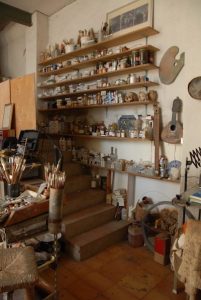
The literature of art by historians and critics is abundant. Around Fine Art Schools and painters’ studios circulate large amounts of treatises on techniques and procedures of the big masters. There are also advanced tools of chemical and spectrographic analysis of materials. However, the knowledge of the intimate and detailed relationship between the artist-painter with these elements is missed. A diary of the work sessions of Van Eyck, Tiziano or Rembrandt, for instance, would be of huge value.
Obviously, this relationship is subjective. The characteristics and possibilities of each material, as well as the election of the procedure to use in every work, entangle with the individual character of the artist and are born in the very root of the creative drive.
In this sense, if this can be useful to someone, I comment here some details of the performance of my own works of art.
In Meninas and tubes, to achieve the lean, fluid, vaporous-looking painting of the background –reproduction in grisaille of the Velázquez’s artwork- I used white oil as it leaves the tube mixed with Titanium white egg tempera emulsified with Stand oil and Dammar varnish. This mixture produces a layer of very receptive consisting semi-matt paint, on which I painted the old tubes with a very different sensibility. To do this I used home-made paint and diverse mediums. The combination of blotting oils and resins gives a large amount of resources of fluidity, grasp of the paint, acceleration or slowdown of the work, glitter or dullness effects, thixotropy and so on.
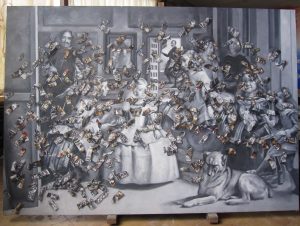
Usually, linseed, nut or poppy purified oils produce a soft paint, easy to melt and transmits sweetness. The oils cooked with lead or copper oxide, thickened to the sun or polymerised, lone, combined each other, thinned with an essence of turpentine, white spirit, wax or aspic, produce a hard, powerful paint of glossy and greasy appearance.
With the natural resins of Dammar and mastic, or the synthetic, alkyd, ketone ones you can work practically the same. However, the hard resin of copal transmits to the painter its depth and hardness, persuading him to a slow paint and the use of alternated glazes and fillings, particularly when it is combined with the turpentine of Venice.
Oil paints as they leave the tube limit the possibilities. The use of the paintbrush, the spatula or fingers is due to the expressive need that the painter recognises in the dialogue with the procedure and the materials that he uses. The full effectiveness of the technical knowledge is when it has been internalised, becoming intuition; used as a recipe leads to a sterilising academicism.
In The Pietà of barbed wire I raised a technique in line with the drama of the subject. I reduced the palette to the plumb white, yellow and red soils, ultramarine and mineral black. I used a medium of linseed oil cooked with litharge and wax, copal resin, Stand oil and aspic. I painted it with layers, from lean to greasy, with thin zones for the background and pronounced fillings where appropriate.
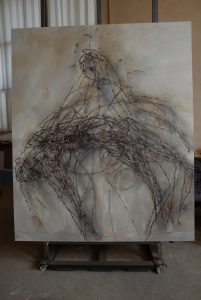
Both for the big paintings Assumption of the Virgin (high altarpiece of the co-cathedral of Castellón, Spain) and for The Last Supper (martyrs chapel, parochial church of Nules, Spain), I used the egg tempera technique emulsified with polymerised oil and Dammar varnish, whose advantages are a diaphanous, matt paint, of insurmountable duration and beauty of colourful. I felt that the rested and thorough technique of the tempera correspond to the subjects of the paintings and the places where they had to be placed.
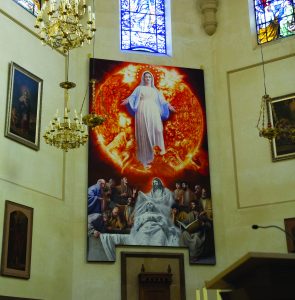
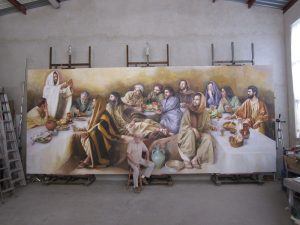
I think that it is very useful the exchange of experiences between professionals of the painting. This maybe redirects us to the excellences of the old workshops where, although the limitations of the epoch, the wisdom and devotion of the painters for their work, they achieved works of art that current technology has not yet overcome.
*
From now the blog entries will depend on my artistic events, exhibitions, inauguration of a painting, etc. so if you want to be informed of the updates, please send me your e-mail to travercalzada@gmail.com to include you in my mailing list.


No Comments